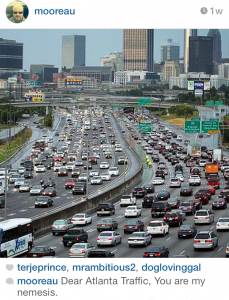#4
Konrad, Miriam Fiedler. Transporting Atlanta. [electronic Resource] : The Mode of Mobility under Construction. 2006., 2006. EBSCOhost. Web.

This book was about how the greatest struggles are all centered around mobility and the lack thereof. From years ago starting from ” forty years in the desert, to the middle passage, the Trail of Tears, diaspora, dislocation, expatriation, repatriation, immigration, emigration, access to work, school, play, home and so much more.” This book also talks about how if we add more cars we should add more roads and that would obscure the view, of what we call natural and what is looked to be obvious blurring the lines of progress. Atlanta traffic problem is not just known by people who live there, but travelers know what to expect. The traffic is so bad when talking about Atlanta comedians jokes are often about the traffic. The book talks about how the number of cars rise while the roads seem to shrink.”The built environment both proscribes and describes where and how we are going and the discourse that both reflects and creates that environment too often goes examined.” The government have not taken in account of the growing population not just in people, but in number of drivers we gain each year. Disputes over land usage has slowed the process of expansion and progress in soothing out the main problems we have in Atlanta’s traffic. Since i commute to school I understand the traffic problem. I do not have class till twelve but i have to wake up at nine and leave by ten just to get to school and find parking.
#5
Hankins, Katherine B., Robert Cochran, and Kate Driscoll Derickson. “Making Space, Making Race: Reconstituting White Privilege In Buckhead, Atlanta.” Social & Cultural Geography 13.4 (2012): 379. Advanced Placement Source. Web. 28 Feb. 2016.

This book was about the unchanging world of Buckhead. If you wanted to describe Georgia’s Buckhead you could compare it to Georgetown in Washington. Buckhead is almost identical to the Buckhead in 1990. The mixture of night clubs and old money and around 81 percent white. Unlike Atlanta’s population of whites which is 33 percent. This book describes how the “tradition” of Buckhead population has put aside the growing opportunities for the rest of Atlanta. “This book contributes to our understanding of the ways in which racial discourses materialize in the remaking of the built environment and associated social geographies.”(Hankins, Katherine) This helps my understanding of the built environment because of a previous article discussed in class. To keep certain race of people out, in the past, they used the built environment to create homes too expensive for the minorities. This is still being used today by the markets in Buckhead. “…decades Buckhead had been the epicenter of wealth in Atlanta, characterized by expensive real estate and luxury retail.”(Hankins, Katherine) The six blocks of misunderstood Atlanta has outsider looking into the separation. This article contributes to the built environment description by discovering a space in which the built environment has made exclusive to a consistent group of people.
#6
Konrad, Miriam Fiedler. Transporting Atlanta. [electronic Resource] : The Mode of Mobility under Construction. 2006., 2006. EBSCOhost. Web.

This is a collection of cases where people have witnessed the homelessness in Atlanta. A mixture of religious leaders government officials have commented on the visible homelessness. Most believe that what you do not see does not exist. The homelessness of Atlanta is visible and can be seen on most streets. It was thought that different government programs should be set up to help the different group of people, the visible poor. The cases were collected in waves to show the difference between two times. the 1900s-1970s and 1975-2000. It is easier to hide the poverty now then it was in the past. To hide the poor we use the built environment to tear down older buildings and build new expensive places. These actions force the poor out and away from the public eye. The religious leaders took the plan to recognize visible homelessness by giving shelter to those in need. When the number of visible homeless grew but the space the churches had to house them did not, then is when the population began to see the problem at hand. “he experience of sheltering and the confrontations with downtown business and political leaders fostered the development of frames with greater complexity and highlighted internal contradictions in the movement.” In my opinion the visible homeless are growing more rapidly then building being reconstructed and built. To fix the problems we have we must first identify them.

